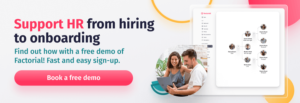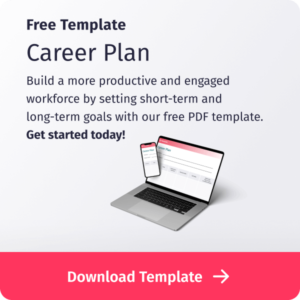Job offer negotiations can be exhausting.
Imagine this: You’ve completed the recruitment process for a new role in your organization. You’ve written the job description, conducted interviews, and extended an offer to the top candidate. Great! Your work should be done.
However, you learn that the candidate has received a counter offer from their current employer—a potential nightmare! It’s not uncommon for candidates to get counter offers when they resign, but these offers often address only surface issues, not the underlying reasons that led them to job hunt in the first place. In fact, 50-80% of employees who accept counter offers end up leaving their company within six months due to ongoing problems.
So, how can you effectively manage counter offers and reduce the chances of your candidates facing this dilemma? The key lies in asking the right interview questions and providing enticing incentives to your top candidates.
Let’s explore how to minimize the risk of counter offers impacting your hiring process.
TABLE OF CONTENTS
What is a Counter Offer?
Why Do Employers Make Counter Offers?
Offering Incentives to Top Candidates
Recruitment and Onboarding with Factorial
Learn more about ATS & Onboarding Software ✅
What is a Counter Offer?
A counter offer occurs when a candidate’s current employer presents them with a seemingly more attractive package upon receiving their resignation. This can be extremely frustrating for you as a hiring manager, considering the effort you’ve invested in interviewing them and determining their suitability for the role.
Job offer negotiations or counter offers from current employers typically takes one of three forms:
- Higher salary: Salary negotiation is perhaps the most common type of counter offer, as it’s generally the easiest and quickest option to implement.
- Promotion: Suddenly, the coveted role with greater responsibilities that the candidate desired becomes available as soon as they submit their notice.
- Benefits: The company may extend additional perks, such as flexible working hours, increased annual leave, or health insurance, in an attempt to persuade the candidate to remain.
Why Do Employers Make Counter Offers?
Employers have several reasons for making counter offers to top candidates. Once again, counteroffer management typically falls into three categories:
- Recruitment and training costs: Hiring a new candidate at the average US salary can cost up to 4,700$ or more, making it understandable why employers aim to retain their current team members. Moreover, if the organization utilizes recruitment consultants, the expenses can be even higher.
- Reduction in productivity: The recruitment process can be time-consuming, and if there’s no immediate replacement for the departing employee, the business may experience decreased output or even a loss of income.
- Pride: Particularly in the case of small and medium-sized enterprises (SMEs), businesses may be displeased that their top candidate has secured a better position elsewhere. They will seek to negotiate a more favorable arrangement to retain their employee, especially if it prevents them from joining a competitor.
Offering Incentives to Top Candidates
If you believe you’ve found the ideal candidate for a position but are concerned they might accept a counter offer or have multiple offers to consider, consider offering incentives to entice top candidates. There are numerous benefits you can provide to make your organization an attractive destination for their next career move:
1. Flexible working
Flexible working is one of the most sought-after benefits in the US. According to SHRM, forty-eight percent of about 1,700 surveyed workers in the U.S. said they will “definitely” seek a remote position for their next job. This hints that many wokers prefer flexible working hours. If you don’t offer this perk, your job offer may lose some of its appeal. With working from home or hybrid policies becoming more prevalent, explore ways to provide flexible working arrangements. The 2021 Gartner Digital Worker Experience Survey found that 43% of respondents believed that working from home and flexible hours boosted productivity, so offering this perk could enhance your business’s output.
Related: Remote Work: Ultimate Guide to Working From Home
2. Employee assistance programs (EAP)
If you don’t already have an EAP in place, consider implementing one. EAPs offer crucial support to staff members dealing with physical or mental health challenges, whether personal or work-related. These programs grant your team access to free, confidential advice, services, and perks aimed at improving their well-being, ultimately enhancing job performance and job satisfaction. Common EAP offerings include counseling, health insurance, financial support, and discounted gym memberships. Demonstrating a commitment to your employees’ well-being, both inside and outside the workplace, can sway a candidate in favor of your job offer.
3. Generous annual leave
Offering a generous annual leave package showcases your understanding of the importance of work-life balance and taking regular breaks. In the US, workers are typically offered between 5 to 15 days of paid time off per year, including holidays. To make your job offer stand out, consider providing additional annual leave days. Assess your budget and explore ways to make your annual leave policy more attractive.
4. Clear career progression plans
Commit to your team’s ongoing learning and development by offering clear career progression plans. Top candidates seek positions that promise promotion opportunities, additional responsibilities, and training to advance within the organization. They want more than just a job title; they want assurance that they’ll have the chance to acquire new skills and grow professionally. It may be helpful to have a sample personal development plan ready to illustrate potential progression within your organization.
5. Market-rate salary
While training and development are important to top candidates, they still have financial needs and salary expectations. Research the market rate for the role you’re hiring for, and if you encounter an exceptional candidate, offer them a competitive salary that reflects their worth. Otherwise, their current employer might counter with a pay raise, potentially diverting their attention. Salary negotiations can be tricky, but demonstrating your appreciation for a candidate by offering the appropriate compensation can expedite their decision regarding your employment offer.
6. Sign-on bonuses
In today’s candidate-driven job market, many companies use sign-on bonuses to attract new team members. These bonuses are often provided in cash after the employee completes their probation period. However, you can negotiate with your top candidate to determine what type of bonus would be most appealing to them. They might prefer a paid training course on a subject of interest or additional annual leave, demonstrating that the bonus doesn’t necessarily have to have a direct monetary value.
Weigh your options
In job offer negotiations, there’s more to consider than just offering a higher salary. Both employers and potential employees should explore all available options. Employers can research comparable positions at other companies and determine how to enhance their benefits package in a sustainable manner. Candidates, on the other hand, should weigh the pros and cons of switching to a new employer, considering that a higher salary at their current organization might not address the underlying reasons that led them to seek a new position.
In conclusion, employers should offer a comprehensive package that includes a competitive salary, relevant career development opportunities, and a healthy work-life balance to reduce the risk of counter offers. What can your business do to mitigate this risk the next time you’re hiring?
Recruitment and Onboarding with Factorial
Factorial offers a comprehensive HR software solution that revolutionizes talent acquisition and onboarding processes. Our platform empowers you to efficiently recruit and nurture employees in a personalized, fast, and user-friendly manner, eliminating the need for manual processes like spreadsheets, email chains, or sticky notes.
By unifying the hiring process for both managers and applicants, our software ensures seamless integration for new employees. This results in enhanced employee satisfaction, better role preparation, increased productivity, and overall company success. Such improved experiences contribute to stronger employer branding, making your company more appealing to top talent in the future.
With Factorial, the entire employee lifecycle is seamlessly managed within the platform, providing various features to enhance your HR processes:
– Build a captivating careers page to attract a larger pool of candidates and optimize your recruiting process.
– Elevate your employer branding effortlessly with custom-generated careers pages that attract more potential candidates.
– Tailor application forms to match your specific requirements.
– Guarantee timely responses to all candidates’ applications.
– Personalize job offers, application forms, and pipeline steps for a more engaging candidate experience.
– Centralize and automate your onboarding and offboarding procedures for maximum efficiency.
– Create personalized onboarding experiences for new employees, ensuring a smooth transition into their roles.
– Establish structured task flows to guide new employees during their onboarding journey.
– Facilitate the exchange of responsibilities between employees throughout the onboarding and offboarding processes.
– Centralize all employee documents and personal information for easy access and data management.
With Factorial’s HR software, you can transform your talent acquisition and onboarding processes, leading to a more successful and attractive workplace for top talents.
Learn more about Factorial’s Applicant Tracking Software here!





